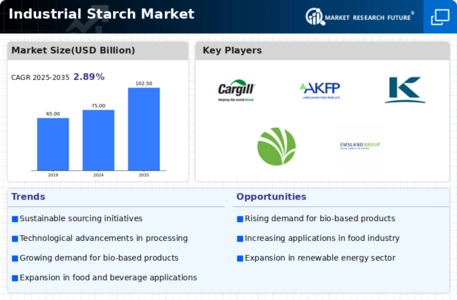-
EXECUTIVE SUMMARY
-
Market Overview
-
Key Findings
-
Market Segmentation
-
Competitive Landscape
-
Challenges and Opportunities
-
Future Outlook
-
MARKET INTRODUCTION
-
Definition
-
Scope of the study
- Research Objective
- Assumption
- Limitations
-
RESEARCH METHODOLOGY
-
Overview
-
Data Mining
-
Secondary Research
-
Primary Research
- Primary Interviews and Information Gathering Process
- Breakdown of Primary Respondents
-
Forecasting Model
-
Market Size Estimation
- Bottom-Up Approach
- Top-Down Approach
-
Data Triangulation
-
Validation
-
MARKET DYNAMICS
-
Overview
-
Drivers
-
Restraints
-
Opportunities
-
MARKET FACTOR ANALYSIS
-
Value chain Analysis
-
Porter's Five Forces Analysis
- Bargaining Power of Suppliers
- Bargaining Power of Buyers
- Threat of New Entrants
- Threat of Substitutes
- Intensity of Rivalry
-
COVID-19 Impact Analysis
- Market Impact Analysis
- Regional Impact
- Opportunity and Threat Analysis
-
INDUSTRIAL STARCH MARKET, BY APPLICATION (USD BILLION)
-
Food Beverage
-
Pharmaceutical
-
Textile
-
Paper
-
Biodegradable Plastics
-
INDUSTRIAL STARCH MARKET, BY SOURCE (USD BILLION)
-
Corn
-
Potato
-
Wheat
-
Tapioca
-
Cassava
-
INDUSTRIAL STARCH MARKET, BY TYPE (USD BILLION)
-
Native Starch
-
Modified Starch
-
Organic Starch
-
Pre-gelatinized Starch
-
INDUSTRIAL STARCH MARKET, BY END USE (USD BILLION)
-
Food Industry
-
Non-Food Industry
-
Animal Feed
-
Adhesives
-
INDUSTRIAL STARCH MARKET, BY REGIONAL (USD BILLION)
-
North America
- US
- Canada
-
Europe
- Germany
- UK
- France
- Russia
- Italy
- Spain
- Rest of Europe
-
APAC
- China
- India
- Japan
- South Korea
- Malaysia
- Thailand
- Indonesia
- Rest of APAC
-
South America
- Brazil
- Mexico
- Argentina
- Rest of South America
-
MEA
- GCC Countries
- South Africa
- Rest of MEA
-
COMPETITIVE LANDSCAPE
-
Overview
-
Competitive Analysis
-
Market share Analysis
-
Major Growth Strategy in the Industrial Starch Market
-
Competitive Benchmarking
-
Leading Players in Terms of Number of Developments in the Industrial Starch Market
-
Key developments and growth strategies
- New Product Launch/Service Deployment
- Merger Acquisitions
- Joint Ventures
-
Major Players Financial Matrix
- Sales and Operating Income
- Major Players RD Expenditure. 2023
-
COMPANY PROFILES
-
Memphis Biofuels
- Financial Overview
- Products Offered
- Key Developments
- SWOT Analysis
- Key Strategies
-
Tereos Syral
- Financial Overview
- Products Offered
- Key Developments
- SWOT Analysis
- Key Strategies
-
Cargill
- Financial Overview
- Products Offered
- Key Developments
- SWOT Analysis
- Key Strategies
-
ADM
- Financial Overview
- Products Offered
- Key Developments
- SWOT Analysis
- Key Strategies
-
Ingredion
- Financial Overview
- Products Offered
- Key Developments
- SWOT Analysis
- Key Strategies
-
Corn Products International
- Financial Overview
- Products Offered
- Key Developments
- SWOT Analysis
- Key Strategies
-
KMC Kartoffelmelcentralen
- Financial Overview
- Products Offered
- Key Developments
- SWOT Analysis
- Key Strategies
-
Sweetener Supply Corporation
- Financial Overview
- Products Offered
- Key Developments
- SWOT Analysis
- Key Strategies
-
Universal StarchChem Allied Ltd.
- Financial Overview
- Products Offered
- Key Developments
- SWOT Analysis
- Key Strategies
-
BASF
- Financial Overview
- Products Offered
- Key Developments
- SWOT Analysis
- Key Strategies
-
Emsland Group
- Financial Overview
- Products Offered
- Key Developments
- SWOT Analysis
- Key Strategies
-
Tate and Lyle
- Financial Overview
- Products Offered
- Key Developments
- SWOT Analysis
- Key Strategies
-
Penford Corporation
- Financial Overview
- Products Offered
- Key Developments
- SWOT Analysis
- Key Strategies
-
AquaGel
- Financial Overview
- Products Offered
- Key Developments
- SWOT Analysis
- Key Strategies
-
APPENDIX
-
References
-
Related Reports
-
LIST OF TABLES
-
LIST OF ASSUMPTIONS
-
NORTH AMERICA INDUSTRIAL STARCH MARKET SIZE ESTIMATES & FORECAST, BY APPLICATION, 2019-2035 (USD BILLIONS)
-
NORTH AMERICA INDUSTRIAL STARCH MARKET SIZE ESTIMATES & FORECAST, BY SOURCE, 2019-2035 (USD BILLIONS)
-
NORTH AMERICA INDUSTRIAL STARCH MARKET SIZE ESTIMATES & FORECAST, BY TYPE, 2019-2035 (USD BILLIONS)
-
NORTH AMERICA INDUSTRIAL STARCH MARKET SIZE ESTIMATES & FORECAST, BY END USE, 2019-2035 (USD BILLIONS)
-
NORTH AMERICA INDUSTRIAL STARCH MARKET SIZE ESTIMATES & FORECAST, BY REGIONAL, 2019-2035 (USD BILLIONS)
-
US INDUSTRIAL STARCH MARKET SIZE ESTIMATES & FORECAST, BY APPLICATION, 2019-2035 (USD BILLIONS)
-
US INDUSTRIAL STARCH MARKET SIZE ESTIMATES & FORECAST, BY SOURCE, 2019-2035 (USD BILLIONS)
-
US INDUSTRIAL STARCH MARKET SIZE ESTIMATES & FORECAST, BY TYPE, 2019-2035 (USD BILLIONS)
-
US INDUSTRIAL STARCH MARKET SIZE ESTIMATES & FORECAST, BY END USE, 2019-2035 (USD BILLIONS)
-
US INDUSTRIAL STARCH MARKET SIZE ESTIMATES & FORECAST, BY REGIONAL, 2019-2035 (USD BILLIONS)
-
CANADA INDUSTRIAL STARCH MARKET SIZE ESTIMATES & FORECAST, BY APPLICATION, 2019-2035 (USD BILLIONS)
-
CANADA INDUSTRIAL STARCH MARKET SIZE ESTIMATES & FORECAST, BY SOURCE, 2019-2035 (USD BILLIONS)
-
CANADA INDUSTRIAL STARCH MARKET SIZE ESTIMATES & FORECAST, BY TYPE, 2019-2035 (USD BILLIONS)
-
CANADA INDUSTRIAL STARCH MARKET SIZE ESTIMATES & FORECAST, BY END USE, 2019-2035 (USD BILLIONS)
-
CANADA INDUSTRIAL STARCH MARKET SIZE ESTIMATES & FORECAST, BY REGIONAL, 2019-2035 (USD BILLIONS)
-
EUROPE INDUSTRIAL STARCH MARKET SIZE ESTIMATES & FORECAST, BY APPLICATION, 2019-2035 (USD BILLIONS)
-
EUROPE INDUSTRIAL STARCH MARKET SIZE ESTIMATES & FORECAST, BY SOURCE, 2019-2035 (USD BILLIONS)
-
EUROPE INDUSTRIAL STARCH MARKET SIZE ESTIMATES & FORECAST, BY TYPE, 2019-2035 (USD BILLIONS)
-
EUROPE INDUSTRIAL STARCH MARKET SIZE ESTIMATES & FORECAST, BY END USE, 2019-2035 (USD BILLIONS)
-
EUROPE INDUSTRIAL STARCH MARKET SIZE ESTIMATES & FORECAST, BY REGIONAL, 2019-2035 (USD BILLIONS)
-
GERMANY INDUSTRIAL STARCH MARKET SIZE ESTIMATES & FORECAST, BY APPLICATION, 2019-2035 (USD BILLIONS)
-
GERMANY INDUSTRIAL STARCH MARKET SIZE ESTIMATES & FORECAST, BY SOURCE, 2019-2035 (USD BILLIONS)
-
GERMANY INDUSTRIAL STARCH MARKET SIZE ESTIMATES & FORECAST, BY TYPE, 2019-2035 (USD BILLIONS)
-
GERMANY INDUSTRIAL STARCH MARKET SIZE ESTIMATES & FORECAST, BY END USE, 2019-2035 (USD BILLIONS)
-
GERMANY INDUSTRIAL STARCH MARKET SIZE ESTIMATES & FORECAST, BY REGIONAL, 2019-2035 (USD BILLIONS)
-
UK INDUSTRIAL STARCH MARKET SIZE ESTIMATES & FORECAST, BY APPLICATION, 2019-2035 (USD BILLIONS)
-
UK INDUSTRIAL STARCH MARKET SIZE ESTIMATES & FORECAST, BY SOURCE, 2019-2035 (USD BILLIONS)
-
UK INDUSTRIAL STARCH MARKET SIZE ESTIMATES & FORECAST, BY TYPE, 2019-2035 (USD BILLIONS)
-
UK INDUSTRIAL STARCH MARKET SIZE ESTIMATES & FORECAST, BY END USE, 2019-2035 (USD BILLIONS)
-
UK INDUSTRIAL STARCH MARKET SIZE ESTIMATES & FORECAST, BY REGIONAL, 2019-2035 (USD BILLIONS)
-
FRANCE INDUSTRIAL STARCH MARKET SIZE ESTIMATES & FORECAST, BY APPLICATION, 2019-2035 (USD BILLIONS)
-
FRANCE INDUSTRIAL STARCH MARKET SIZE ESTIMATES & FORECAST, BY SOURCE, 2019-2035 (USD BILLIONS)
-
FRANCE INDUSTRIAL STARCH MARKET SIZE ESTIMATES & FORECAST, BY TYPE, 2019-2035 (USD BILLIONS)
-
FRANCE INDUSTRIAL STARCH MARKET SIZE ESTIMATES & FORECAST, BY END USE, 2019-2035 (USD BILLIONS)
-
FRANCE INDUSTRIAL STARCH MARKET SIZE ESTIMATES & FORECAST, BY REGIONAL, 2019-2035 (USD BILLIONS)
-
RUSSIA INDUSTRIAL STARCH MARKET SIZE ESTIMATES & FORECAST, BY APPLICATION, 2019-2035 (USD BILLIONS)
-
RUSSIA INDUSTRIAL STARCH MARKET SIZE ESTIMATES & FORECAST, BY SOURCE, 2019-2035 (USD BILLIONS)
-
RUSSIA INDUSTRIAL STARCH MARKET SIZE ESTIMATES & FORECAST, BY TYPE, 2019-2035 (USD BILLIONS)
-
RUSSIA INDUSTRIAL STARCH MARKET SIZE ESTIMATES & FORECAST, BY END USE, 2019-2035 (USD BILLIONS)
-
RUSSIA INDUSTRIAL STARCH MARKET SIZE ESTIMATES & FORECAST, BY REGIONAL, 2019-2035 (USD BILLIONS)
-
ITALY INDUSTRIAL STARCH MARKET SIZE ESTIMATES & FORECAST, BY APPLICATION, 2019-2035 (USD BILLIONS)
-
ITALY INDUSTRIAL STARCH MARKET SIZE ESTIMATES & FORECAST, BY SOURCE, 2019-2035 (USD BILLIONS)
-
ITALY INDUSTRIAL STARCH MARKET SIZE ESTIMATES & FORECAST, BY TYPE, 2019-2035 (USD BILLIONS)
-
ITALY INDUSTRIAL STARCH MARKET SIZE ESTIMATES & FORECAST, BY END USE, 2019-2035 (USD BILLIONS)
-
ITALY INDUSTRIAL STARCH MARKET SIZE ESTIMATES & FORECAST, BY REGIONAL, 2019-2035 (USD BILLIONS)
-
SPAIN INDUSTRIAL STARCH MARKET SIZE ESTIMATES & FORECAST, BY APPLICATION, 2019-2035 (USD BILLIONS)
-
SPAIN INDUSTRIAL STARCH MARKET SIZE ESTIMATES & FORECAST, BY SOURCE, 2019-2035 (USD BILLIONS)
-
SPAIN INDUSTRIAL STARCH MARKET SIZE ESTIMATES & FORECAST, BY TYPE, 2019-2035 (USD BILLIONS)
-
SPAIN INDUSTRIAL STARCH MARKET SIZE ESTIMATES & FORECAST, BY END USE, 2019-2035 (USD BILLIONS)
-
SPAIN INDUSTRIAL STARCH MARKET SIZE ESTIMATES & FORECAST, BY REGIONAL, 2019-2035 (USD BILLIONS)
-
REST OF EUROPE INDUSTRIAL STARCH MARKET SIZE ESTIMATES & FORECAST, BY APPLICATION, 2019-2035 (USD BILLIONS)
-
REST OF EUROPE INDUSTRIAL STARCH MARKET SIZE ESTIMATES & FORECAST, BY SOURCE, 2019-2035 (USD BILLIONS)
-
REST OF EUROPE INDUSTRIAL STARCH MARKET SIZE ESTIMATES & FORECAST, BY TYPE, 2019-2035 (USD BILLIONS)
-
REST OF EUROPE INDUSTRIAL STARCH MARKET SIZE ESTIMATES & FORECAST, BY END USE, 2019-2035 (USD BILLIONS)
-
REST OF EUROPE INDUSTRIAL STARCH MARKET SIZE ESTIMATES & FORECAST, BY REGIONAL, 2019-2035 (USD BILLIONS)
-
APAC INDUSTRIAL STARCH MARKET SIZE ESTIMATES & FORECAST, BY APPLICATION, 2019-2035 (USD BILLIONS)
-
APAC INDUSTRIAL STARCH MARKET SIZE ESTIMATES & FORECAST, BY SOURCE, 2019-2035 (USD BILLIONS)
-
APAC INDUSTRIAL STARCH MARKET SIZE ESTIMATES & FORECAST, BY TYPE, 2019-2035 (USD BILLIONS)
-
APAC INDUSTRIAL STARCH MARKET SIZE ESTIMATES & FORECAST, BY END USE, 2019-2035 (USD BILLIONS)
-
APAC INDUSTRIAL STARCH MARKET SIZE ESTIMATES & FORECAST, BY REGIONAL, 2019-2035 (USD BILLIONS)
-
CHINA INDUSTRIAL STARCH MARKET SIZE ESTIMATES & FORECAST, BY APPLICATION, 2019-2035 (USD BILLIONS)
-
CHINA INDUSTRIAL STARCH MARKET SIZE ESTIMATES & FORECAST, BY SOURCE, 2019-2035 (USD BILLIONS)
-
CHINA INDUSTRIAL STARCH MARKET SIZE ESTIMATES & FORECAST, BY TYPE, 2019-2035 (USD BILLIONS)
-
CHINA INDUSTRIAL STARCH MARKET SIZE ESTIMATES & FORECAST, BY END USE, 2019-2035 (USD BILLIONS)
-
CHINA INDUSTRIAL STARCH MARKET SIZE ESTIMATES & FORECAST, BY REGIONAL, 2019-2035 (USD BILLIONS)
-
INDIA INDUSTRIAL STARCH MARKET SIZE ESTIMATES & FORECAST, BY APPLICATION, 2019-2035 (USD BILLIONS)
-
INDIA INDUSTRIAL STARCH MARKET SIZE ESTIMATES & FORECAST, BY SOURCE, 2019-2035 (USD BILLIONS)
-
INDIA INDUSTRIAL STARCH MARKET SIZE ESTIMATES & FORECAST, BY TYPE, 2019-2035 (USD BILLIONS)
-
INDIA INDUSTRIAL STARCH MARKET SIZE ESTIMATES & FORECAST, BY END USE, 2019-2035 (USD BILLIONS)
-
INDIA INDUSTRIAL STARCH MARKET SIZE ESTIMATES & FORECAST, BY REGIONAL, 2019-2035 (USD BILLIONS)
-
JAPAN INDUSTRIAL STARCH MARKET SIZE ESTIMATES & FORECAST, BY APPLICATION, 2019-2035 (USD BILLIONS)
-
JAPAN INDUSTRIAL STARCH MARKET SIZE ESTIMATES & FORECAST, BY SOURCE, 2019-2035 (USD BILLIONS)
-
JAPAN INDUSTRIAL STARCH MARKET SIZE ESTIMATES & FORECAST, BY TYPE, 2019-2035 (USD BILLIONS)
-
JAPAN INDUSTRIAL STARCH MARKET SIZE ESTIMATES & FORECAST, BY END USE, 2019-2035 (USD BILLIONS)
-
JAPAN INDUSTRIAL STARCH MARKET SIZE ESTIMATES & FORECAST, BY REGIONAL, 2019-2035 (USD BILLIONS)
-
SOUTH KOREA INDUSTRIAL STARCH MARKET SIZE ESTIMATES & FORECAST, BY APPLICATION, 2019-2035 (USD BILLIONS)
-
SOUTH KOREA INDUSTRIAL STARCH MARKET SIZE ESTIMATES & FORECAST, BY SOURCE, 2019-2035 (USD BILLIONS)
-
SOUTH KOREA INDUSTRIAL STARCH MARKET SIZE ESTIMATES & FORECAST, BY TYPE, 2019-2035 (USD BILLIONS)
-
SOUTH KOREA INDUSTRIAL STARCH MARKET SIZE ESTIMATES & FORECAST, BY END USE, 2019-2035 (USD BILLIONS)
-
SOUTH KOREA INDUSTRIAL STARCH MARKET SIZE ESTIMATES & FORECAST, BY REGIONAL, 2019-2035 (USD BILLIONS)
-
MALAYSIA INDUSTRIAL STARCH MARKET SIZE ESTIMATES & FORECAST, BY APPLICATION, 2019-2035 (USD BILLIONS)
-
MALAYSIA INDUSTRIAL STARCH MARKET SIZE ESTIMATES & FORECAST, BY SOURCE, 2019-2035 (USD BILLIONS)
-
MALAYSIA INDUSTRIAL STARCH MARKET SIZE ESTIMATES & FORECAST, BY TYPE, 2019-2035 (USD BILLIONS)
-
MALAYSIA INDUSTRIAL STARCH MARKET SIZE ESTIMATES & FORECAST, BY END USE, 2019-2035 (USD BILLIONS)
-
MALAYSIA INDUSTRIAL STARCH MARKET SIZE ESTIMATES & FORECAST, BY REGIONAL, 2019-2035 (USD BILLIONS)
-
THAILAND INDUSTRIAL STARCH MARKET SIZE ESTIMATES & FORECAST, BY APPLICATION, 2019-2035 (USD BILLIONS)
-
THAILAND INDUSTRIAL STARCH MARKET SIZE ESTIMATES & FORECAST, BY SOURCE, 2019-2035 (USD BILLIONS)
-
THAILAND INDUSTRIAL STARCH MARKET SIZE ESTIMATES & FORECAST, BY TYPE, 2019-2035 (USD BILLIONS)
-
THAILAND INDUSTRIAL STARCH MARKET SIZE ESTIMATES & FORECAST, BY END USE, 2019-2035 (USD BILLIONS)
-
THAILAND INDUSTRIAL STARCH MARKET SIZE ESTIMATES & FORECAST, BY REGIONAL, 2019-2035 (USD BILLIONS)
-
INDONESIA INDUSTRIAL STARCH MARKET SIZE ESTIMATES & FORECAST, BY APPLICATION, 2019-2035 (USD BILLIONS)
-
INDONESIA INDUSTRIAL STARCH MARKET SIZE ESTIMATES & FORECAST, BY SOURCE, 2019-2035 (USD BILLIONS)
-
INDONESIA INDUSTRIAL STARCH MARKET SIZE ESTIMATES & FORECAST, BY TYPE, 2019-2035 (USD BILLIONS)
-
INDONESIA INDUSTRIAL STARCH MARKET SIZE ESTIMATES & FORECAST, BY END USE, 2019-2035 (USD BILLIONS)
-
INDONESIA INDUSTRIAL STARCH MARKET SIZE ESTIMATES & FORECAST, BY REGIONAL, 2019-2035 (USD BILLIONS)
-
REST OF APAC INDUSTRIAL STARCH MARKET SIZE ESTIMATES & FORECAST, BY APPLICATION, 2019-2035 (USD BILLIONS)
-
REST OF APAC INDUSTRIAL STARCH MARKET SIZE ESTIMATES & FORECAST, BY SOURCE, 2019-2035 (USD BILLIONS)
-
REST OF APAC INDUSTRIAL STARCH MARKET SIZE ESTIMATES & FORECAST, BY TYPE, 2019-2035 (USD BILLIONS)
-
REST OF APAC INDUSTRIAL STARCH MARKET SIZE ESTIMATES & FORECAST, BY END USE, 2019-2035 (USD BILLIONS)
-
REST OF APAC INDUSTRIAL STARCH MARKET SIZE ESTIMATES & FORECAST, BY REGIONAL, 2019-2035 (USD BILLIONS)
-
SOUTH AMERICA INDUSTRIAL STARCH MARKET SIZE ESTIMATES & FORECAST, BY APPLICATION, 2019-2035 (USD BILLIONS)
-
SOUTH AMERICA INDUSTRIAL STARCH MARKET SIZE ESTIMATES & FORECAST, BY SOURCE, 2019-2035 (USD BILLIONS)
-
SOUTH AMERICA INDUSTRIAL STARCH MARKET SIZE ESTIMATES & FORECAST, BY TYPE, 2019-2035 (USD BILLIONS)
-
SOUTH AMERICA INDUSTRIAL STARCH MARKET SIZE ESTIMATES & FORECAST, BY END USE, 2019-2035 (USD BILLIONS)
-
SOUTH AMERICA INDUSTRIAL STARCH MARKET SIZE ESTIMATES & FORECAST, BY REGIONAL, 2019-2035 (USD BILLIONS)
-
BRAZIL INDUSTRIAL STARCH MARKET SIZE ESTIMATES & FORECAST, BY APPLICATION, 2019-2035 (USD BILLIONS)
-
BRAZIL INDUSTRIAL STARCH MARKET SIZE ESTIMATES & FORECAST, BY SOURCE, 2019-2035 (USD BILLIONS)
-
BRAZIL INDUSTRIAL STARCH MARKET SIZE ESTIMATES & FORECAST, BY TYPE, 2019-2035 (USD BILLIONS)
-
BRAZIL INDUSTRIAL STARCH MARKET SIZE ESTIMATES & FORECAST, BY END USE, 2019-2035 (USD BILLIONS)
-
BRAZIL INDUSTRIAL STARCH MARKET SIZE ESTIMATES & FORECAST, BY REGIONAL, 2019-2035 (USD BILLIONS)
-
MEXICO INDUSTRIAL STARCH MARKET SIZE ESTIMATES & FORECAST, BY APPLICATION, 2019-2035 (USD BILLIONS)
-
MEXICO INDUSTRIAL STARCH MARKET SIZE ESTIMATES & FORECAST, BY SOURCE, 2019-2035 (USD BILLIONS)
-
MEXICO INDUSTRIAL STARCH MARKET SIZE ESTIMATES & FORECAST, BY TYPE, 2019-2035 (USD BILLIONS)
-
MEXICO INDUSTRIAL STARCH MARKET SIZE ESTIMATES & FORECAST, BY END USE, 2019-2035 (USD BILLIONS)
-
MEXICO INDUSTRIAL STARCH MARKET SIZE ESTIMATES & FORECAST, BY REGIONAL, 2019-2035 (USD BILLIONS)
-
ARGENTINA INDUSTRIAL STARCH MARKET SIZE ESTIMATES & FORECAST, BY APPLICATION, 2019-2035 (USD BILLIONS)
-
ARGENTINA INDUSTRIAL STARCH MARKET SIZE ESTIMATES & FORECAST, BY SOURCE, 2019-2035 (USD BILLIONS)
-
ARGENTINA INDUSTRIAL STARCH MARKET SIZE ESTIMATES & FORECAST, BY TYPE, 2019-2035 (USD BILLIONS)
-
ARGENTINA INDUSTRIAL STARCH MARKET SIZE ESTIMATES & FORECAST, BY END USE, 2019-2035 (USD BILLIONS)
-
ARGENTINA INDUSTRIAL STARCH MARKET SIZE ESTIMATES & FORECAST, BY REGIONAL, 2019-2035 (USD BILLIONS)
-
REST OF SOUTH AMERICA INDUSTRIAL STARCH MARKET SIZE ESTIMATES & FORECAST, BY APPLICATION, 2019-2035 (USD BILLIONS)
-
REST OF SOUTH AMERICA INDUSTRIAL STARCH MARKET SIZE ESTIMATES & FORECAST, BY SOURCE, 2019-2035 (USD BILLIONS)
-
REST OF SOUTH AMERICA INDUSTRIAL STARCH MARKET SIZE ESTIMATES & FORECAST, BY TYPE, 2019-2035 (USD BILLIONS)
-
REST OF SOUTH AMERICA INDUSTRIAL STARCH MARKET SIZE ESTIMATES & FORECAST, BY END USE, 2019-2035 (USD BILLIONS)
-
REST OF SOUTH AMERICA INDUSTRIAL STARCH MARKET SIZE ESTIMATES & FORECAST, BY REGIONAL, 2019-2035 (USD BILLIONS)
-
MEA INDUSTRIAL STARCH MARKET SIZE ESTIMATES & FORECAST, BY APPLICATION, 2019-2035 (USD BILLIONS)
-
MEA INDUSTRIAL STARCH MARKET SIZE ESTIMATES & FORECAST, BY SOURCE, 2019-2035 (USD BILLIONS)
-
MEA INDUSTRIAL STARCH MARKET SIZE ESTIMATES & FORECAST, BY TYPE, 2019-2035 (USD BILLIONS)
-
MEA INDUSTRIAL STARCH MARKET SIZE ESTIMATES & FORECAST, BY END USE, 2019-2035 (USD BILLIONS)
-
MEA INDUSTRIAL STARCH MARKET SIZE ESTIMATES & FORECAST, BY REGIONAL, 2019-2035 (USD BILLIONS)
-
GCC COUNTRIES INDUSTRIAL STARCH MARKET SIZE ESTIMATES & FORECAST, BY APPLICATION, 2019-2035 (USD BILLIONS)
-
GCC COUNTRIES INDUSTRIAL STARCH MARKET SIZE ESTIMATES & FORECAST, BY SOURCE, 2019-2035 (USD BILLIONS)
-
GCC COUNTRIES INDUSTRIAL STARCH MARKET SIZE ESTIMATES & FORECAST, BY TYPE, 2019-2035 (USD BILLIONS)
-
GCC COUNTRIES INDUSTRIAL STARCH MARKET SIZE ESTIMATES & FORECAST, BY END USE, 2019-2035 (USD BILLIONS)
-
GCC COUNTRIES INDUSTRIAL STARCH MARKET SIZE ESTIMATES & FORECAST, BY REGIONAL, 2019-2035 (USD BILLIONS)
-
SOUTH AFRICA INDUSTRIAL STARCH MARKET SIZE ESTIMATES & FORECAST, BY APPLICATION, 2019-2035 (USD BILLIONS)
-
SOUTH AFRICA INDUSTRIAL STARCH MARKET SIZE ESTIMATES & FORECAST, BY SOURCE, 2019-2035 (USD BILLIONS)
-
SOUTH AFRICA INDUSTRIAL STARCH MARKET SIZE ESTIMATES & FORECAST, BY TYPE, 2019-2035 (USD BILLIONS)
-
SOUTH AFRICA INDUSTRIAL STARCH MARKET SIZE ESTIMATES & FORECAST, BY END USE, 2019-2035 (USD BILLIONS)
-
SOUTH AFRICA INDUSTRIAL STARCH MARKET SIZE ESTIMATES & FORECAST, BY REGIONAL, 2019-2035 (USD BILLIONS)
-
REST OF MEA INDUSTRIAL STARCH MARKET SIZE ESTIMATES & FORECAST, BY APPLICATION, 2019-2035 (USD BILLIONS)
-
REST OF MEA INDUSTRIAL STARCH MARKET SIZE ESTIMATES & FORECAST, BY SOURCE, 2019-2035 (USD BILLIONS)
-
REST OF MEA INDUSTRIAL STARCH MARKET SIZE ESTIMATES & FORECAST, BY TYPE, 2019-2035 (USD BILLIONS)
-
REST OF MEA INDUSTRIAL STARCH MARKET SIZE ESTIMATES & FORECAST, BY END USE, 2019-2035 (USD BILLIONS)
-
REST OF MEA INDUSTRIAL STARCH MARKET SIZE ESTIMATES & FORECAST, BY REGIONAL, 2019-2035 (USD BILLIONS)
-
PRODUCT LAUNCH/PRODUCT DEVELOPMENT/APPROVAL
-
ACQUISITION/PARTNERSHIP
-
LIST OF FIGURES
-
MARKET SYNOPSIS
-
NORTH AMERICA INDUSTRIAL STARCH MARKET ANALYSIS
-
US INDUSTRIAL STARCH MARKET ANALYSIS BY APPLICATION
-
US INDUSTRIAL STARCH MARKET ANALYSIS BY SOURCE
-
US INDUSTRIAL STARCH MARKET ANALYSIS BY TYPE
-
US INDUSTRIAL STARCH MARKET ANALYSIS BY END USE
-
US INDUSTRIAL STARCH MARKET ANALYSIS BY REGIONAL
-
CANADA INDUSTRIAL STARCH MARKET ANALYSIS BY APPLICATION
-
CANADA INDUSTRIAL STARCH MARKET ANALYSIS BY SOURCE
-
CANADA INDUSTRIAL STARCH MARKET ANALYSIS BY TYPE
-
CANADA INDUSTRIAL STARCH MARKET ANALYSIS BY END USE
-
CANADA INDUSTRIAL STARCH MARKET ANALYSIS BY REGIONAL
-
EUROPE INDUSTRIAL STARCH MARKET ANALYSIS
-
GERMANY INDUSTRIAL STARCH MARKET ANALYSIS BY APPLICATION
-
GERMANY INDUSTRIAL STARCH MARKET ANALYSIS BY SOURCE
-
GERMANY INDUSTRIAL STARCH MARKET ANALYSIS BY TYPE
-
GERMANY INDUSTRIAL STARCH MARKET ANALYSIS BY END USE
-
GERMANY INDUSTRIAL STARCH MARKET ANALYSIS BY REGIONAL
-
UK INDUSTRIAL STARCH MARKET ANALYSIS BY APPLICATION
-
UK INDUSTRIAL STARCH MARKET ANALYSIS BY SOURCE
-
UK INDUSTRIAL STARCH MARKET ANALYSIS BY TYPE
-
UK INDUSTRIAL STARCH MARKET ANALYSIS BY END USE
-
UK INDUSTRIAL STARCH MARKET ANALYSIS BY REGIONAL
-
FRANCE INDUSTRIAL STARCH MARKET ANALYSIS BY APPLICATION
-
FRANCE INDUSTRIAL STARCH MARKET ANALYSIS BY SOURCE
-
FRANCE INDUSTRIAL STARCH MARKET ANALYSIS BY TYPE
-
FRANCE INDUSTRIAL STARCH MARKET ANALYSIS BY END USE
-
FRANCE INDUSTRIAL STARCH MARKET ANALYSIS BY REGIONAL
-
RUSSIA INDUSTRIAL STARCH MARKET ANALYSIS BY APPLICATION
-
RUSSIA INDUSTRIAL STARCH MARKET ANALYSIS BY SOURCE
-
RUSSIA INDUSTRIAL STARCH MARKET ANALYSIS BY TYPE
-
RUSSIA INDUSTRIAL STARCH MARKET ANALYSIS BY END USE
-
RUSSIA INDUSTRIAL STARCH MARKET ANALYSIS BY REGIONAL
-
ITALY INDUSTRIAL STARCH MARKET ANALYSIS BY APPLICATION
-
ITALY INDUSTRIAL STARCH MARKET ANALYSIS BY SOURCE
-
ITALY INDUSTRIAL STARCH MARKET ANALYSIS BY TYPE
-
ITALY INDUSTRIAL STARCH MARKET ANALYSIS BY END USE
-
ITALY INDUSTRIAL STARCH MARKET ANALYSIS BY REGIONAL
-
SPAIN INDUSTRIAL STARCH MARKET ANALYSIS BY APPLICATION
-
SPAIN INDUSTRIAL STARCH MARKET ANALYSIS BY SOURCE
-
SPAIN INDUSTRIAL STARCH MARKET ANALYSIS BY TYPE
-
SPAIN INDUSTRIAL STARCH MARKET ANALYSIS BY END USE
-
SPAIN INDUSTRIAL STARCH MARKET ANALYSIS BY REGIONAL
-
REST OF EUROPE INDUSTRIAL STARCH MARKET ANALYSIS BY APPLICATION
-
REST OF EUROPE INDUSTRIAL STARCH MARKET ANALYSIS BY SOURCE
-
REST OF EUROPE INDUSTRIAL STARCH MARKET ANALYSIS BY TYPE
-
REST OF EUROPE INDUSTRIAL STARCH MARKET ANALYSIS BY END USE
-
REST OF EUROPE INDUSTRIAL STARCH MARKET ANALYSIS BY REGIONAL
-
APAC INDUSTRIAL STARCH MARKET ANALYSIS
-
CHINA INDUSTRIAL STARCH MARKET ANALYSIS BY APPLICATION
-
CHINA INDUSTRIAL STARCH MARKET ANALYSIS BY SOURCE
-
CHINA INDUSTRIAL STARCH MARKET ANALYSIS BY TYPE
-
CHINA INDUSTRIAL STARCH MARKET ANALYSIS BY END USE
-
CHINA INDUSTRIAL STARCH MARKET ANALYSIS BY REGIONAL
-
INDIA INDUSTRIAL STARCH MARKET ANALYSIS BY APPLICATION
-
INDIA INDUSTRIAL STARCH MARKET ANALYSIS BY SOURCE
-
INDIA INDUSTRIAL STARCH MARKET ANALYSIS BY TYPE
-
INDIA INDUSTRIAL STARCH MARKET ANALYSIS BY END USE
-
INDIA INDUSTRIAL STARCH MARKET ANALYSIS BY REGIONAL
-
JAPAN INDUSTRIAL STARCH MARKET ANALYSIS BY APPLICATION
-
JAPAN INDUSTRIAL STARCH MARKET ANALYSIS BY SOURCE
-
JAPAN INDUSTRIAL STARCH MARKET ANALYSIS BY TYPE
-
JAPAN INDUSTRIAL STARCH MARKET ANALYSIS BY END USE
-
JAPAN INDUSTRIAL STARCH MARKET ANALYSIS BY REGIONAL
-
SOUTH KOREA INDUSTRIAL STARCH MARKET ANALYSIS BY APPLICATION
-
SOUTH KOREA INDUSTRIAL STARCH MARKET ANALYSIS BY SOURCE
-
SOUTH KOREA INDUSTRIAL STARCH MARKET ANALYSIS BY TYPE
-
SOUTH KOREA INDUSTRIAL STARCH MARKET ANALYSIS BY END USE
-
SOUTH KOREA INDUSTRIAL STARCH MARKET ANALYSIS BY REGIONAL
-
MALAYSIA INDUSTRIAL STARCH MARKET ANALYSIS BY APPLICATION
-
MALAYSIA INDUSTRIAL STARCH MARKET ANALYSIS BY SOURCE
-
MALAYSIA INDUSTRIAL STARCH MARKET ANALYSIS BY TYPE
-
MALAYSIA INDUSTRIAL STARCH MARKET ANALYSIS BY END USE
-
MALAYSIA INDUSTRIAL STARCH MARKET ANALYSIS BY REGIONAL
-
THAILAND INDUSTRIAL STARCH MARKET ANALYSIS BY APPLICATION
-
THAILAND INDUSTRIAL STARCH MARKET ANALYSIS BY SOURCE
-
THAILAND INDUSTRIAL STARCH MARKET ANALYSIS BY TYPE
-
THAILAND INDUSTRIAL STARCH MARKET ANALYSIS BY END USE
-
THAILAND INDUSTRIAL STARCH MARKET ANALYSIS BY REGIONAL
-
INDONESIA INDUSTRIAL STARCH MARKET ANALYSIS BY APPLICATION
-
INDONESIA INDUSTRIAL STARCH MARKET ANALYSIS BY SOURCE
-
INDONESIA INDUSTRIAL STARCH MARKET ANALYSIS BY TYPE
-
INDONESIA INDUSTRIAL STARCH MARKET ANALYSIS BY END USE
-
INDONESIA INDUSTRIAL STARCH MARKET ANALYSIS BY REGIONAL
-
REST OF APAC INDUSTRIAL STARCH MARKET ANALYSIS BY APPLICATION
-
REST OF APAC INDUSTRIAL STARCH MARKET ANALYSIS BY SOURCE
-
REST OF APAC INDUSTRIAL STARCH MARKET ANALYSIS BY TYPE
-
REST OF APAC INDUSTRIAL STARCH MARKET ANALYSIS BY END USE
-
REST OF APAC INDUSTRIAL STARCH MARKET ANALYSIS BY REGIONAL
-
SOUTH AMERICA INDUSTRIAL STARCH MARKET ANALYSIS
-
BRAZIL INDUSTRIAL STARCH MARKET ANALYSIS BY APPLICATION
-
BRAZIL INDUSTRIAL STARCH MARKET ANALYSIS BY SOURCE
-
BRAZIL INDUSTRIAL STARCH MARKET ANALYSIS BY TYPE
-
BRAZIL INDUSTRIAL STARCH MARKET ANALYSIS BY END USE
-
BRAZIL INDUSTRIAL STARCH MARKET ANALYSIS BY REGIONAL
-
MEXICO INDUSTRIAL STARCH MARKET ANALYSIS BY APPLICATION
-
MEXICO INDUSTRIAL STARCH MARKET ANALYSIS BY SOURCE
-
MEXICO INDUSTRIAL STARCH MARKET ANALYSIS BY TYPE
-
MEXICO INDUSTRIAL STARCH MARKET ANALYSIS BY END USE
-
MEXICO INDUSTRIAL STARCH MARKET ANALYSIS BY REGIONAL
-
ARGENTINA INDUSTRIAL STARCH MARKET ANALYSIS BY APPLICATION
-
ARGENTINA INDUSTRIAL STARCH MARKET ANALYSIS BY SOURCE
-
ARGENTINA INDUSTRIAL STARCH MARKET ANALYSIS BY TYPE
-
ARGENTINA INDUSTRIAL STARCH MARKET ANALYSIS BY END USE
-
ARGENTINA INDUSTRIAL STARCH MARKET ANALYSIS BY REGIONAL
-
REST OF SOUTH AMERICA INDUSTRIAL STARCH MARKET ANALYSIS BY APPLICATION
-
REST OF SOUTH AMERICA INDUSTRIAL STARCH MARKET ANALYSIS BY SOURCE
-
REST OF SOUTH AMERICA INDUSTRIAL STARCH MARKET ANALYSIS BY TYPE
-
REST OF SOUTH AMERICA INDUSTRIAL STARCH MARKET ANALYSIS BY END USE
-
REST OF SOUTH AMERICA INDUSTRIAL STARCH MARKET ANALYSIS BY REGIONAL
-
MEA INDUSTRIAL STARCH MARKET ANALYSIS
-
GCC COUNTRIES INDUSTRIAL STARCH MARKET ANALYSIS BY APPLICATION
-
GCC COUNTRIES INDUSTRIAL STARCH MARKET ANALYSIS BY SOURCE
-
GCC COUNTRIES INDUSTRIAL STARCH MARKET ANALYSIS BY TYPE
-
GCC COUNTRIES INDUSTRIAL STARCH MARKET ANALYSIS BY END USE
-
GCC COUNTRIES INDUSTRIAL STARCH MARKET ANALYSIS BY REGIONAL
-
SOUTH AFRICA INDUSTRIAL STARCH MARKET ANALYSIS BY APPLICATION
-
SOUTH AFRICA INDUSTRIAL STARCH MARKET ANALYSIS BY SOURCE
-
SOUTH AFRICA INDUSTRIAL STARCH MARKET ANALYSIS BY TYPE
-
SOUTH AFRICA INDUSTRIAL STARCH MARKET ANALYSIS BY END USE
-
SOUTH AFRICA INDUSTRIAL STARCH MARKET ANALYSIS BY REGIONAL
-
REST OF MEA INDUSTRIAL STARCH MARKET ANALYSIS BY APPLICATION
-
REST OF MEA INDUSTRIAL STARCH MARKET ANALYSIS BY SOURCE
-
REST OF MEA INDUSTRIAL STARCH MARKET ANALYSIS BY TYPE
-
REST OF MEA INDUSTRIAL STARCH MARKET ANALYSIS BY END USE
-
REST OF MEA INDUSTRIAL STARCH MARKET ANALYSIS BY REGIONAL
-
KEY BUYING CRITERIA OF INDUSTRIAL STARCH MARKET
-
RESEARCH PROCESS OF MRFR
-
DRO ANALYSIS OF INDUSTRIAL STARCH MARKET
-
DRIVERS IMPACT ANALYSIS: INDUSTRIAL STARCH MARKET
-
RESTRAINTS IMPACT ANALYSIS: INDUSTRIAL STARCH MARKET
-
SUPPLY / VALUE CHAIN: INDUSTRIAL STARCH MARKET
-
INDUSTRIAL STARCH MARKET, BY APPLICATION, 2025 (% SHARE)
-
INDUSTRIAL STARCH MARKET, BY APPLICATION, 2019 TO 2035 (USD Billions)
-
INDUSTRIAL STARCH MARKET, BY SOURCE, 2025 (% SHARE)
-
INDUSTRIAL STARCH MARKET, BY SOURCE, 2019 TO 2035 (USD Billions)
-
INDUSTRIAL STARCH MARKET, BY TYPE, 2025 (% SHARE)
-
INDUSTRIAL STARCH MARKET, BY TYPE, 2019 TO 2035 (USD Billions)
-
INDUSTRIAL STARCH MARKET, BY END USE, 2025 (% SHARE)
-
INDUSTRIAL STARCH MARKET, BY END USE, 2019 TO 2035 (USD Billions)
-
INDUSTRIAL STARCH MARKET, BY REGIONAL, 2025 (% SHARE)
-
INDUSTRIAL STARCH MARKET, BY REGIONAL, 2019 TO 2035 (USD Billions)
-
BENCHMARKING OF MAJOR COMPETITORS

















Leave a Comment